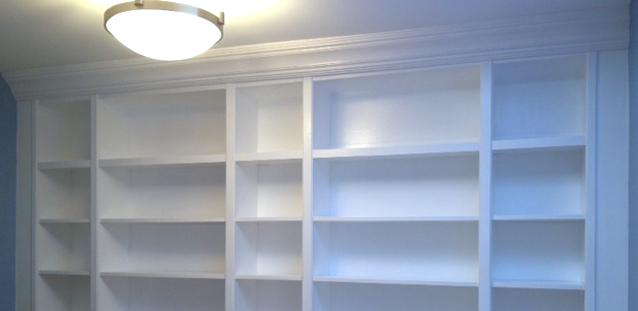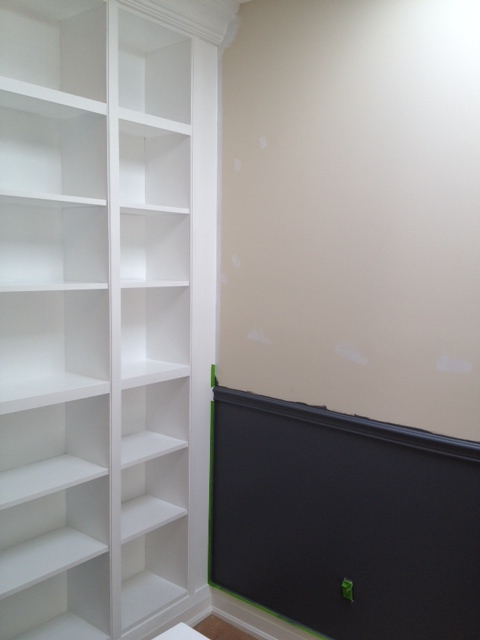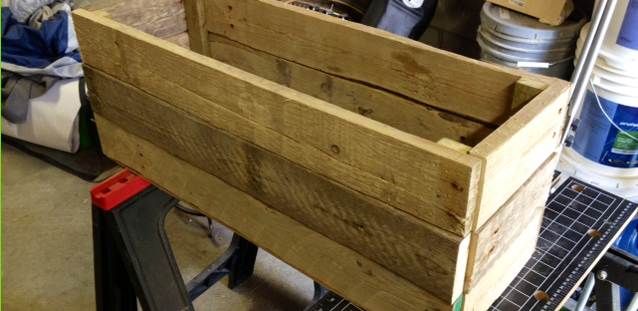I loved the shape and price of the Ikea Ung Drill frame. Continue reading “Ikea Ung Drill Frame to Mirror”
Tag: diy
DIY Outdoor Drapes
At about 3pm, the sun reaches our back deck in full force. If you happen to be sitting out there at that time, it goes from being a dappled shady retreat to a scorching desert. After getting sick of doing the deck chair shuffle until the sun entirely pushes us inside, we decided to buy some outdoor drapes.
Then we realized outdoor drapes are EXPENSIVE! They are really pricy! Especially for 12 foot long ones that I needed for our deck. I waffled over how to make it happen for weeks at a time, and then threw in the towel. We were not getting outdoor drapes.
Then inspiration struck, I could make some! But UGH, that requires a lot of fabric… and any fabric that is nice and heavy and blocks the light…is also expensive. I wasn’t even considering using outdoor fabric.
Then it struck me. Drop cloths! People use those things for everything! I could definitely make outdoor curtains with them. So we headed to Home Depot to buy some 12′ long drop cloth panels, and to find some inspiration on how to hang them. Our deck is 12′ wide. Can we use curtain rods? Nope, couldn’t find any that big. Wooden dowels? Still not available that long. Gas line pipe? ALMOST! But it was 10′ long and heavy, so it would consist of using two pipes and probably having to have a bracket in the middle to hold the weight…Then El Granto had a brilliant idea. Aircraft cable! BINGO! The drop cloths were light, and the aircraft cable could be tensioned into our deck with a turnbuckle. It would be perfect! We picked up a 50′ aircraft cable kit, two turnbuckles, two 4×12′ drop cloths, some large cup hooks, and some tarp grommets.
Back at home, El Granto got up on the ladder and secured the cup hooks to the deck, and attached one end of the cable system. We measured out where we wanted the grommets to go on the drape panels (Odin really wanted to help)

Through some trial and error (who doesn’t put instructions on a grommet kit!?) We finally found the best way to put in the grommets. It involved a vice, some rags, a hammer, and a few swear words. (sorry there are no photos, I was too busy using profanities to take any.) After the grommets were in I measured the drapes to hem them and went inside to get out the sewing machine. I managed to find my sewing machine easily enough, but do you think I could find the box with all the thread and notions?! Not a hope. So I grabbed some hemming tape, and ironed the hems in the drapes. I figured if they fell out, I would go buy some thread and sew them back up. Once they were hemmed, we threaded the grommets of the drape panels onto the aircraft cable, attached the cable to the other side and tensioned it with the turnbuckle.
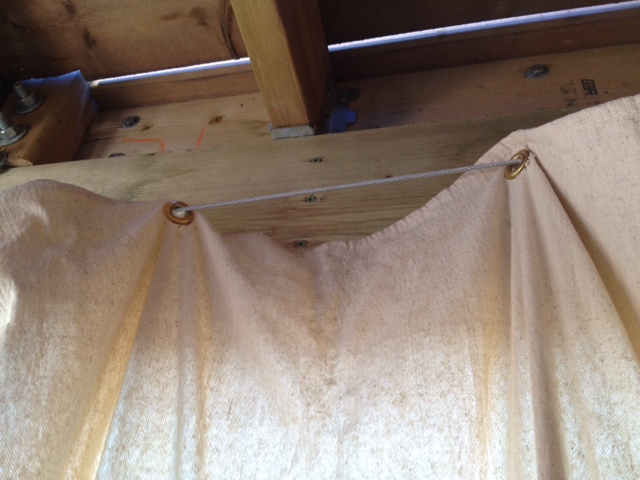
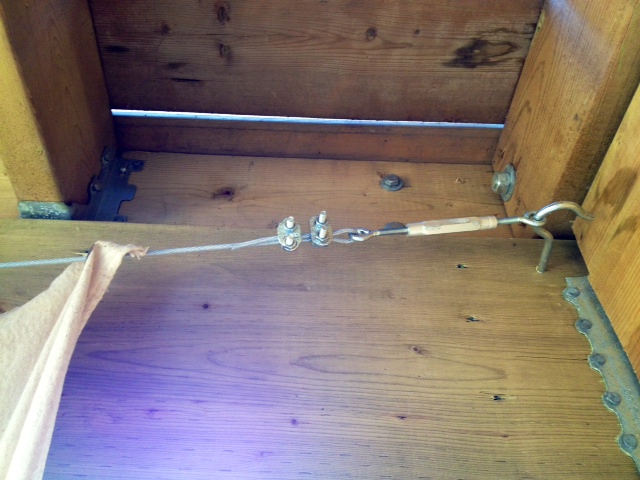
YAY! SHADE! WOOT!
Just one small problem…the space of the cup hook, aircraft cable clamps and turnbuckle means that the drape does not stretch all the way to the side of the deck. One day when we have a bit more patience, we will remove the turnbuckle on the North end of the deck, where the most sun comes in (you really only need one turnbuckle) and it will work and look much nicer.
But enough of my bitching, here are the pics!
Before!

After!
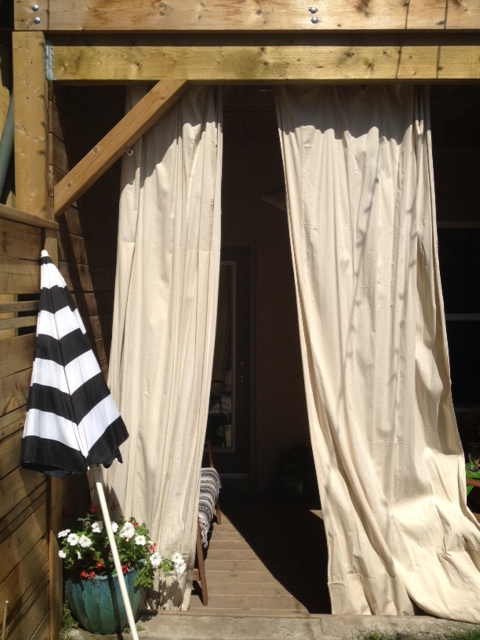
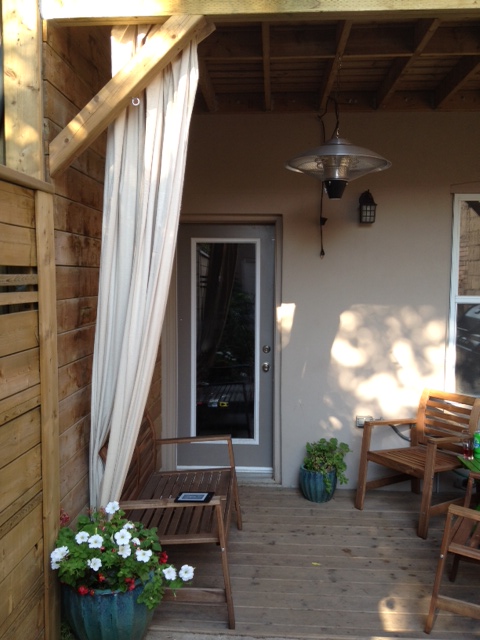
*To answer a few of the questions you may be thinking of:
- Will we leave them out in the winter? We will take them in during the winter, and put them through the wash if necessary
- How have they held up so far? Amazing. Water doesn’t seam to soak into them when it rains, they never stay wet or damp, and show no signs of mold or any other nasties yet.
- Would we change anything? Only adding a tie back/hook for when they are not in use, otherwise its perfect!
- Added Bonus: We have had a sweltering summer, and we have been using the curtains to block some of the sun from hitting the back of the house, and to shade the a/c unit. It has worked wonders.
SOURCE LIST:
Materials:
2x 4×12 Drop Cloths: Home Depot (we only used 2 panels, but could have fit 3 or 4, if your deck gets full sun more panels may be required)
50′ Aircraft Cable Kit: Home Depot
Tarp Grommets: Rona
2 Large Cup Hooks: Home Depot
2 Turnbuckles: Home Depot
Iron-On Hemming Tape: Fabricland
Tools Used:
Ladder, Drill, Measuring Tape, Sewing Machine, Iron, Hammer, Sharpie, Screw Driver, Wire Cutters, Wrench
Difficulty Level (on a scale of 1-5):
Total Cost: $50
From Billy to Built-Ins
Our house is a three bedroom, two large bedrooms and one smaller. The smaller is of course the best choice for either an office or nursery. We wanted to plan for an office now, and if we ever needed it down the road, an easy transition to a nursery. Continue reading “From Billy to Built-Ins”
Painting The Office
I love Amy Butler fabrics. When I stumbled upon the fact that Graham & Brown had an Amy Butler wallpaper line, I was in love. I drooled over the designs, ordered samples, and set my heart on the Fountain Pattern in Stone. Continue reading “Painting The Office”
Installing Office Chair Rail
I like trim & moulding. Scratch that. I am kind of obsessed with it. Especially in an Edwardian home, I feel like we should have trim everywhere. Baseboard, Wainscoting, Board & Batten, Chair Rail, Plate Rail, Crown Moulding. I love and want it all.
So every room we reno, I tend to try to sneak in some trim. The office was no different. It was crying out for a chair rail. The one problem with the office was well, the walls were about as straight as Elton John. My favourite chair rail, which is a solid oak, ¾” thick beauty from Central Fairbank Lumber would be amazing, but would not fair so well with my squiggily walls. I needed something a bit more pliable. So El Granto, Odin & I walked to Downtown Lumber and picked out a lovely simple mdf pre-primed chair rail, and carried it home. Yes, I said carried it home. We do not own a car. So when we need building materials, we either rent the home depot bring it home van, or we buy from Downtown Lumber and walk the 2.8km along the West Toronto Railpath to and from Downtown Lumber. If you ever spy two crazy looking people and their red dog carrying home a 2×4’s on the walking path, that would be us. It’s actually not that bad. One person can easily carry a few 8 foot boards, it’s when it comes to 10 or 12 foot boards, that it’s helpful to have a friend. The biggest thing we brought home were 2x8x12’s for the deck. Those suckers were heavy! The folks at Downtown Lumber are even so kind to tape together multiple boards for me, so it’s easier for me to carry home.
Back to the task at hand… We walked home with our chair rail, and I quickly measured up my walls, and made a cut list. As our miter saw is in the garage, I prefer to do a cut list with all my angles, and head to the garage to cut everything at once. I am anal retentive when it comes to measuring and my trim cuts, so they are usually bang on. I quickly cut all the pieces. It was really simple as the whole room was only 5 pieces, so 10 cuts. My chair rail was a shallower depth then my door molding, so we decided to do flush cuts at the door frames. This means out of my 10 cuts I actually only had to miter the two corners (hint hint, this means that the other two corners in the room house my built in bookcases.) I then marked where the studs were on the wall and brad nailed the trim in place.
Now here is some edumacation for you. This is what a 2” brad nail looks like when you hit a drywall screw in the wall. He’s not a happy nail, neither was El Granto when he had to pull that angry nail back out.
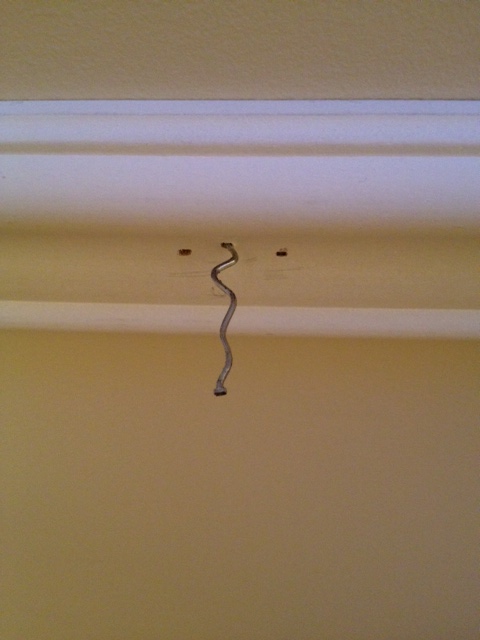
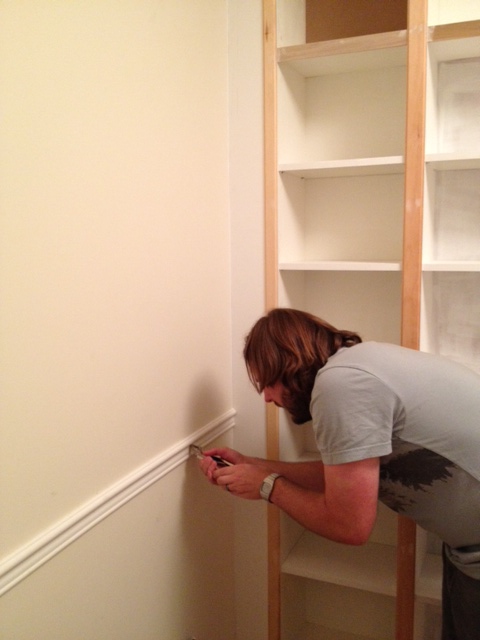
When setting the chair rail position, I originally laid it out level. As the floor is not the least bit level, it looked really off. Instead I decided to make it parallel to the floor, which meant to the eye it would look all nice and straight. In cases like this, doing it right will make it look all wrong. So there is my advice, DO IT WRONG. Brilliant eh? Using the flexible MDF chair rail worked so well. It curved to our wacky walls perfectly. Now, had we painted out the chair rail white it would have accented how crooked the walls are, but as we were painting the chair rail the bottom wall colour, it would (hopefully) blend in.
We then filled all the nail holes with paintable caulk, and ran a tiny bit along the top of the chair rail, which made it look seamless to the wall.
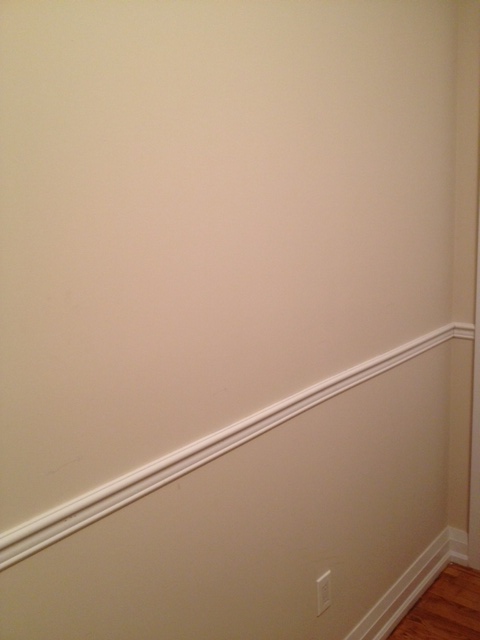
Then it was time to PAINT!
HAHA aren’t I a tease? Painting post tomorrow I promise.
SOURCE LIST:
Materials:
MDF Chair Rail: Downtown Lumber
Brad Nails: My Garage
DAP Paintable Caulking: Home Depot
Tools Used:
Miter Saw, Measuring Tape, Compressor & Brad Nailer, Level
Difficulty Level (on a scale of 1-5):
Total Cost: $40
DIY Pallet Crates
If you have been being a good boy or girl, you will have read my Project Office post and you will know I have a lot to do! One of the items on the To Do list was crates for built in bookshelves. Bookscase DIY tutorial will come soon (I promise) but until then here is a sneak peak on how we made the crates to go ON the bookcase.
I was planning on sourcing some framing grade lumber and roughing it up a bit to get a worn look for my crates. Odin & I happened to be walking through an industrial area in our neighbourhood on Friday when we spied a pile of shipping pallets on the side of the road.
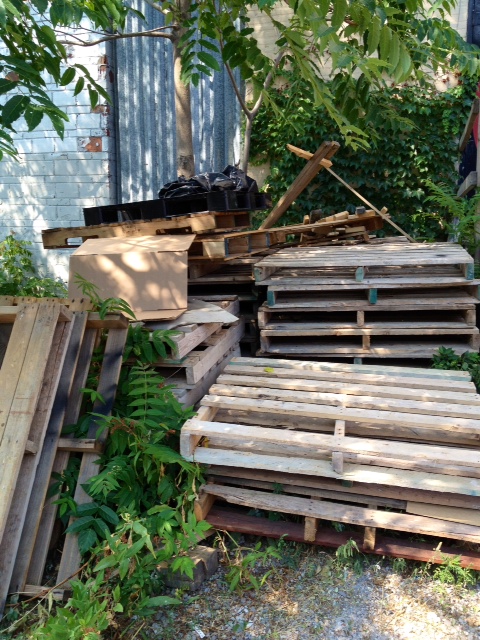
I thought to myself, “self, there some rough wood, and its CHEAP rough wood”. You see, cheap is one of my favorite words. I like it so much that people often use it to describe me. So Saturday morning Odin and I took off to steal grab ourselves one of these pallets. I picked one that looked good, didn’t appear to have hobo pee or bugs on it, so I carried it home. By carried it home, I mean I walked 100 feet, rested, walked 100 more feet and had another rest all the way home. It was also a Saturday morning, and I had to walk past a hipster brunch spot in the neighbourhood looking like a crazy person. The dog happily trotted behind me wondering what on earth I was up to.

After lugging this darn thing home, swearing a few times, wishing I owned a car, and wondering what I was so damn crazy, I finally got down to work. I thought bringing it home was hard, I hadn’t yet met hard. Hard is not owning a crow bar, and trying to take out massive nails with a hammer and Mjölnir to pry and bash them apart.
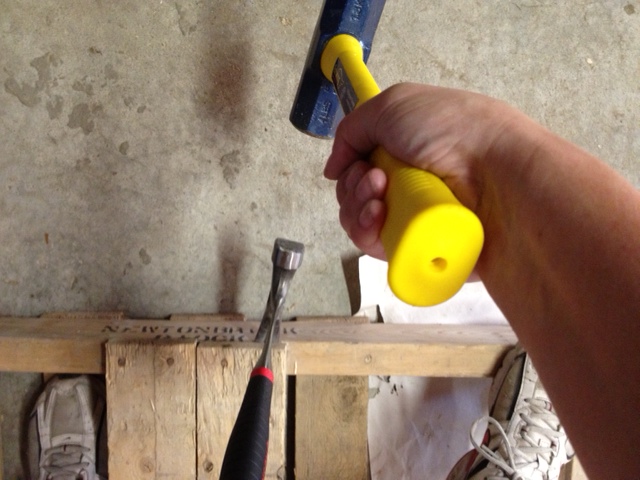
Break time yet? GAH! This is hard work. You are probably asking right now, where on earth is El Granto? He was having a lovely day learning to drive NASCAR’s with his Dad and Brother. At about this point in time I was cursing him in every language that I know a curse word in. These include, English, French, Spanish and German. My mother would be disappointed that I don’t know any Danish curse words. The worst thing I know is how to say underwear in Danish. This was a hit when I was six…
So… I finally managed to pry apart some boards, and then bashed out the nails.

As you can see the wood before sanding is…well kinda gross. It will get better, I promise. Now I put some super rough sandpaper in my palm sander, and set to work.
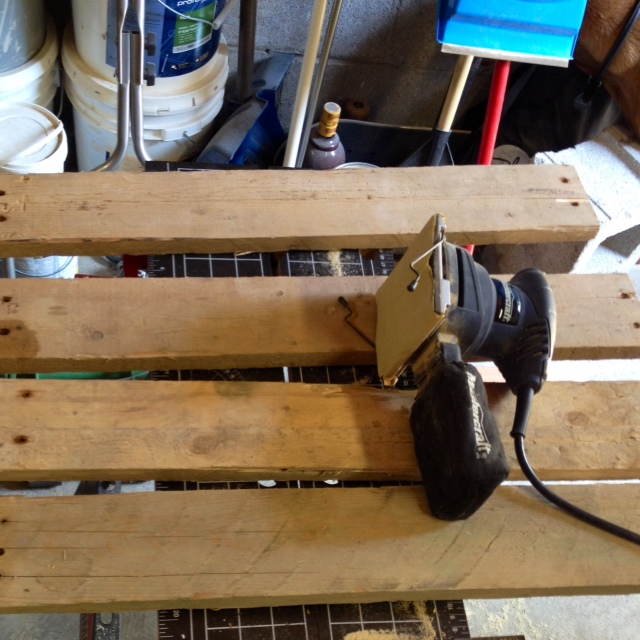
Once I sanded everything, using the dimensions of my bookshelves, I decided on a size for the crates. I wanted them to fit in the bookcase nicely, but have a little room to slide in and out. I drew up a quick diagram on a piece of wood, and started cutting! The finished size for the crates are 29″x10″x11″ and 13″x10″x11″. I cut my front pieces 29″ long for the big ones and 13″ for the small. The sides were 8 1/4″ and each crate was 3 boards high. I cut the boards to length on the miter saw, and used scrap pieces of 1×2’s as corner braces. I attached the front panels to the corner supports using brad nails. I spaced the corner supports 5/8″ in from the edge to allow space for the sides to fit flush.
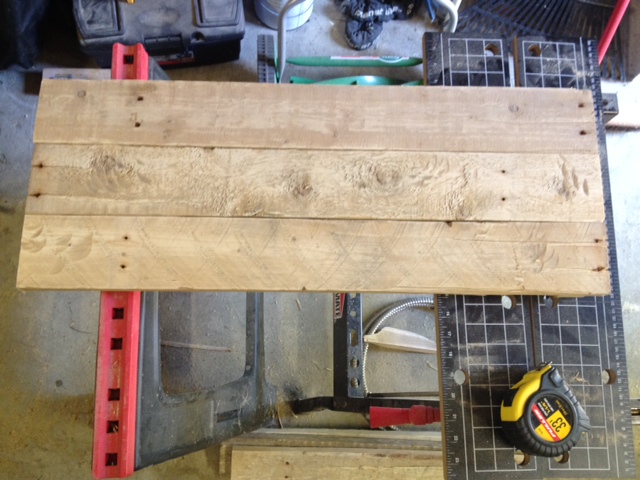
I assembled both the fronts, then attached them to the sides with more brad nails. I then traced a bottom for the crate onto some extra hardboard we had laying around the garage. I cut out the hardboard with the circular saw, and nailed it to the bottom of the crate.
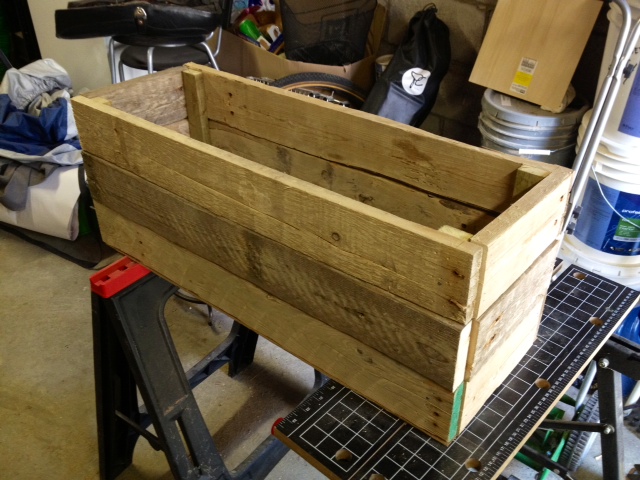
The wood is all different thickness, and I didn’t worry about having everything match perfectly. It just adds to the distressed look. After I had assembled it, I took the palm sander to it again making sure there were no sharp corners or splinters. There, I was done! It only took me 3 hours to make one crate. Wait, what, I need four more of these? DAMMIT! I better get back to work. I sanded and cut the wood to length for one more crate, but I ran out of brad nails. Uck. So I waited for El Granto to get home from his NASCAR adventure and then headed to Canadian Tire to pick up more nails, and some felt furniture sliders for the bottoms of the crates. We also stopped and pilfered one more crate on our way home, which I made El Granto carry, and he cursed me in the same fashion that I had cursed him earlier. Once I got home, a soft couch and a cold drink sounded better than doing more work, so I gave up, and left it for Sunday.
Sunday morning, we got all ready to start work (this time with El Granto in tow). When we went outside our neighbours were putting up a big glass panel on their amazing deck, and asked for some muscle. El Granto went to help, and I got back to work making more crates. El Granto’s work conveniently consisted of standing holding a piece of glass for an hour, then being rewarded with a plethora of yummy beverages. Of course he preferred doing this to helping me make crates…so once again I was bustin my ass alone. El Granto did stop in to help me take apart the second pallet (it’s much easier to watch him then to do it myself.) I proceeded to make one more big crate, and three little ones.

The little ones are cute. Like a puppy version of a crate. I finally finished all five of my crates, and stood back to appreciate my giant stack-o-crates.
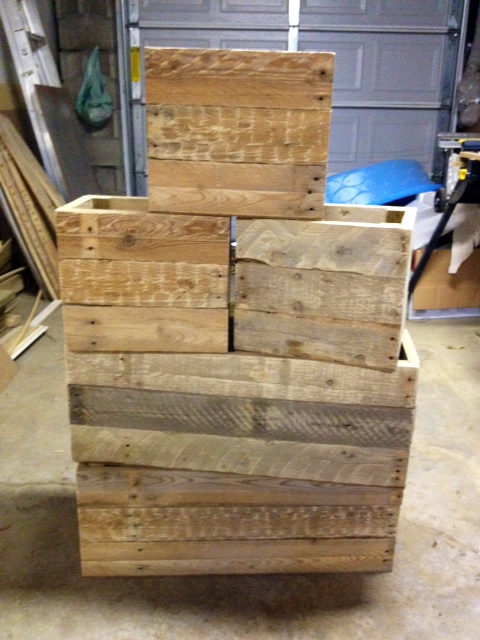
Some of the wood turned out really cool. The ones that look all spotted were really really rough boards, that I sanded and sanded and sanded and they came out all spotty! I also really like the boards with the rough saw marks. I thought I may have to distress the crates more, but I think they look fairly worn. They look like driftwood almost. I was on the fence with staining them, but we like them just the way they are, so we’ll leave them as is for now. They do need some hardware, I am waffling between shiny fancy nickle handles (that I am using elsewhere in the room) or sticking with rustic and using some rope, either as a handle, or making small monkey’s fists and using them as pulls. What do you think?

So what do you think? Free crates, were they a pass or a fail?
UPDATE!
My idea to use pretty polished handles on my crate was overruled by El Granto, my Mom, our neighbours, my co-workers and the garbage man. So rope handles it is!
We checked Rona, and their rope was too big, Home Depot had even bigger rope and some smaller rope. We went with the small one. In hindsight, I wish it was a bit chunkier. Will be keeping an eye out for some bigger rope. Also, check out the completed bookcase here.
SOURCE LIST:
Materials:
Wood Shipping Pallets : side of the road
1×2’s: Pile-o-wood in my garage
1/8″ hardboard: My garage
Brad Nails: Canadian Tire
Sandpaper: Canadian Tire
Felt Furniture Pads: Canadian Tire
Rope: Home Depot
Tools Used:
Maul, Hammer, Circular Saw, Miter Saw, Measuring Tape, Compressor & Brad Nailer
Difficulty Level (on a scale of 1-5):
(cause damn those pallets were heavy!)
Total Cost: $7 for the rope & furniture pads
Project Office
I have been working on our office for SIX MONTHS now. That’s right, half a year! Having a clingy spazzy puppy around doesn’t help. The moment you try to get some work done, he wants to play, or is hungry, or wants to go for a walk, or chew on the baseboard, or just wants so sit there and whine until you stop doing work and pay attention to him.
If having a puppy is this bad, I have no idea how people with babies eat, go pee or bathe. If I ever have kids, I just know I am going to be one of those mothers who puts the baby in the crib screaming and goes downstairs and has a glass of wine.
Where was I? Oh yes the office.
Wrangling the puppy was especially difficult when we were painting, or doing things that he could in no way be near. We would take turns working while the other watched the dog, or built a dog play area in the hallway. Needless to say the simplest task ended up taking days or weeks. I am still finishing a few things up, and a few projects are still incomplete, but it’s finally gotten to a point where I may actually let someone see it.
As for furniture; in our last office we built in a custom desk so when we moved to the storefront the desk stayed behind. We also owned a crappy old office chair, that I happily pushed to the curb before we carried away our last moving box.
So coming into the office in the new house, we owned:
- A filing cabinet covered in El Granto’s music and snowboarding stickers, which is missing the rails to actually hang files on
- A cheap Ikea drawer unit
- LOTS AND LOTS of books, antique cameras and crap.
That is not a lot to work from…Try as hard as I did, you just cant make a desk out of crap. It topples over…
So for the first six months of living in the house we used my Grandmother’s 50 year old Ikea card table as a desk, and a folding chair. More often than not we ended up working with the laptop on the sofa downstairs.
Before I post pictures of all our office projects, here is some insight on what we had planned
My Pinterest Office Inspiration Board
This board is giving away a ton of hints of what we were up to, so stay tuned for the results!
And here is our great big office plan/project to do list.
TO DO:
- Build wall of built in bookshelves
- Add Chair Rail
- Modify and paint Ikea Ingo dining table to use as desk
- Give a facelift to an old Ikea Goliat drawer unit
- Move (ugly) filing cabinet to closet, and add shelves and clothing rod
- Paint the walls
- Change light fixture for one that does not rattle when a truck drives by
- Source old bankers chair for desk (update here)
- Find the perfect reading chair & ottoman
- Find or build side table for reading chair
- Build custom crates for bookshelves
- Hide router, modem and phone gateway, and curb rogue cables
- Hang art
- Shove all our books, antique camera collection and misc crap into the bookcase in some sort of visually pleasing order
- Source interesting reclaimed object as trash can
UGH…I am tired just looking at the list…wheres my drink?
Building a Fence!
Before we got Odin we knew we needed a fence. There was a slightly dilapidated chain link fence between our house and our neighbors to the north (we have a 30′ brick wall to the South and a garage on the West end of our yard). We have an amazing relationship with our neighbors. They are a young family, who is currently renovating their entire house as well. We wanted a fence that would be functional, provide privacy but also allows us to socialize when we want to.
We put pen to paper, and designed a horizontal slat fence with 5″ boards and 2″ boards. We were going for a traditional meets modern design. We then set out to removing the old fence. We prepared shovels and tools, and mustered up the courage to start digging out deep concrete foundations. El Granto started pulling absentmindedly to one of the fence posts and the post easily started to come up, so he pulled more and more, and out came the post! All of the other posts came out just as easily, except one that was too close to our deck foundation, and must have got stuck in the deck’s concrete when it was poured.
Now it was time to build!
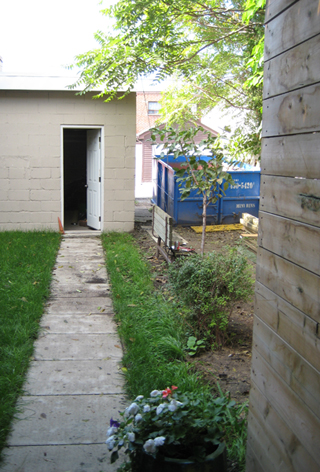
Our fence needed to be 26 feet long, and would be anchored on one end to our 2 story deck, and on the other end to our cinder block garage. We used 4×4 posts for our main supports. We used 10″ bolts to attach one 4×4 to the deck, and masonry screws to attach another to the garage. We then spaced out our two center posts equally so that all the fence panels would be the same size. This would involve loads more cutting, and more wasted wood, but visually it was much nicer.
As we were anchored at both the deck and the garage, we used post spikes for the two center posts. Now don’t you do shaking your finger at me… Yes, we could have dug post holes and filled with cement, but our ground is FULL of rocks, and the thought of digging those holes was, well…unplesent. So we looked into other options. We found the level-able post spikes, and after considering our fence (it was a small span, well anchored at either end, was sheltered by a 30′ wall on one side). It wouldn’t be subject to gale force winds, or pole vaulters, so it would be.just.fine. I will hear none of your “you took the easy way out”. OF COURSE we did. The hard way sucks.
Back to the task at hand. We set the fence spikes and El Granto got to hit things with Mjölnir (yes.. that is what we named for our great big hammer. If you’re ever at our house and need the use of a big hammer, you must ask for Mjölnir, anything else and you will be ignored. (No “Maul”, “Big Ass Hammer”, nothin.)
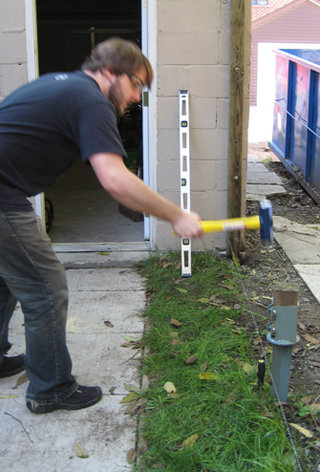
We set the posts, leveled them, and then got to putting on the boards. This would have been a time when two cordless drills would have been handy (hint hint Santa). We spaced the boards right tight up to each other knowing that they would gap some as the wood shrinks.
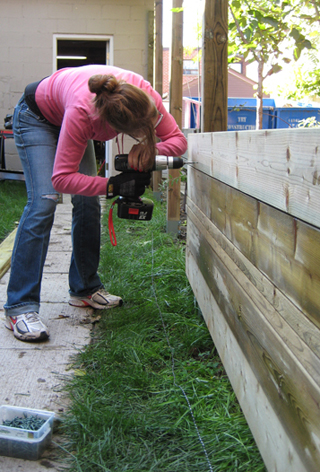
When we got up to eye level, our fence was starting to look like a wall, not a fence, so we spaced out a row of the smaller 2″ boards, so that we would have a space that we could see and converse with our neighbours. Once we finished one fence panel, we dropped a chalk line and cut off the overhanging boards with a circular saw.
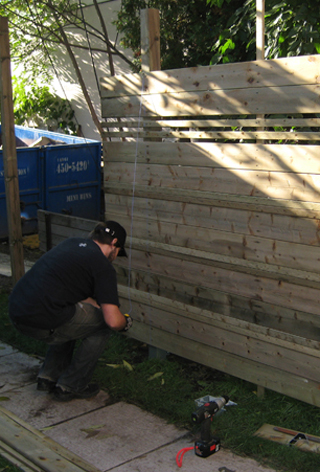
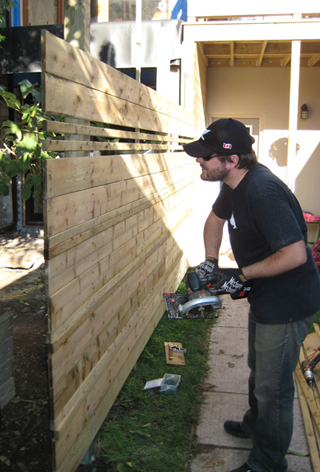
Once we finished fencing all the panels, we placed fence boards vertically where the two panels met to cover the cut marks. We screwed in the last board just as the sun was disappearing. Finishing the top of the fence would need to wait for more daylight and lumber. That was one hard days work, time for a drink!
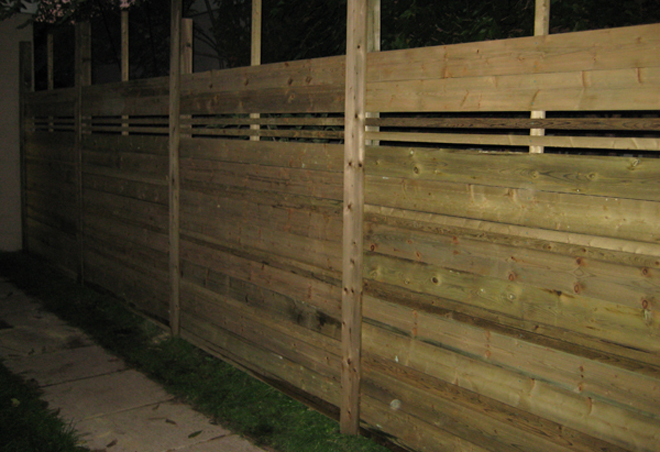
The fence stayed ugly like this for a few weeks until my Mom & Dad came down to help us reinforce the deck (that’s another story for later). While they were helping us, we used the opportunity to borrow Dad’s truck, and head to the lumber store for some 2×6’s to make top rails for the deck.
Here is the finished product!
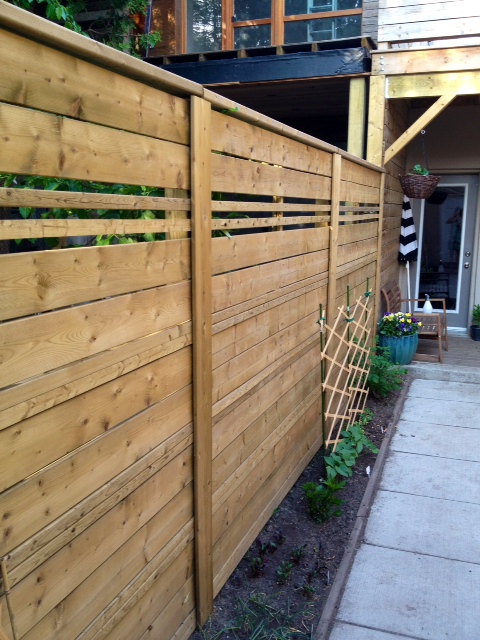

SOURCE LIST:
Materials:
Pressure Treated Lumber (1×2’s, 1×5’s, 4×4’s & 2×6’s) : Downtown Lumber
Fence Spikes: Downtown Lumber
10″ Bolts, 1.5″ Deck Screws: Home Depot
Titen Masonry Screws: Home Depot
Tools Used:
Maul, Circular Saw, Chalk Line, Drill
Difficulty Level (on a scale of 1-5):

